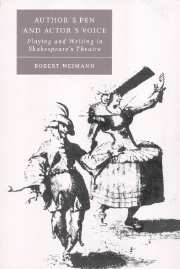Book contents
- Frontmatter
- Contents
- Preface
- Introduction: conjunctures and concepts
- 1 Performance and authority in Hamlet (1603)
- 2 A new agenda for authority
- 3 Pen and voice: versions of doubleness
- 4 Playing with a difference
- 5 Histories in Elizabethan performance
- 6 Hamlet and the purposes of playing
- 7 Space (in)dividable: locus and platea revisited
- 8 Shakespeare's endings: commodious thresholds
- Afterword: thresholds forever after
- Notes
- List of works cited
- Index
1 - Performance and authority in Hamlet (1603)
Published online by Cambridge University Press: 22 September 2009
- Frontmatter
- Contents
- Preface
- Introduction: conjunctures and concepts
- 1 Performance and authority in Hamlet (1603)
- 2 A new agenda for authority
- 3 Pen and voice: versions of doubleness
- 4 Playing with a difference
- 5 Histories in Elizabethan performance
- 6 Hamlet and the purposes of playing
- 7 Space (in)dividable: locus and platea revisited
- 8 Shakespeare's endings: commodious thresholds
- Afterword: thresholds forever after
- Notes
- List of works cited
- Index
Summary
Although Hamlet, as Anthony Scoloker noted in 1604, was perceived as a play that “should please all,” its textual history tells a different story. If, as Philip Edwards observed, the “study of the early texts of Hamlet is the study of a play in motion” (8), the element that is most in question (and in motion) is the circulation of cultural authority itself. At issue is the fluid, composite source of this authority, its unsettled and dispersed locations between the writing and the production of the play. The unstable linkage between the texts and the performances of Hamlet can perhaps best be explored at the point of its own intervention in the forms and functions of playing. At this crucial point – rare in the entire history of the Elizabethan theatre – the actual circulation of authority in the performed play appears revealingly at odds with what in Q2 and F is taken to authorize in no uncertain terms the “purpose of playing” (3.2.20).
In the so-called ‘bad’ quarto Hamlet, relations of writing and playing find themselves in a state of entanglement and differentiation that has a more subdued echo in the difference between the authorial amplitude the Second Quarto (1604) and the more theatrical qualities of the Folio text (1623).
- Type
- Chapter
- Information
- Author's Pen and Actor's VoicePlaying and Writing in Shakespeare's Theatre, pp. 18 - 28Publisher: Cambridge University PressPrint publication year: 2000



